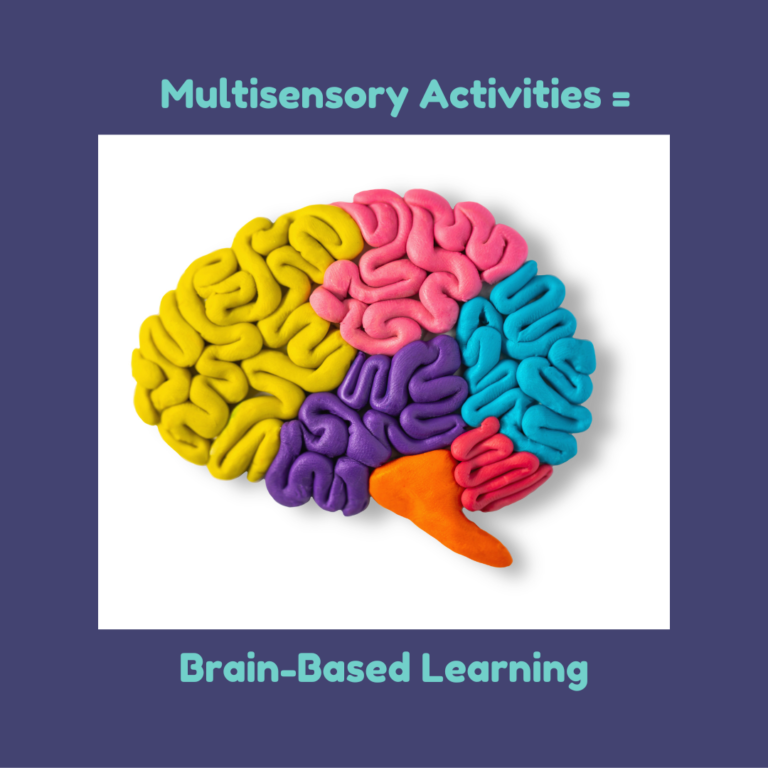In the realm of homeschooling approaches, the traditional approach of delivering information solely through reading textbooks and answer questions is definitely an option. However, for many kids with special learning needs, textbook reading yields only frustration and complete lack of retention of the information. Other homeschool approaches, such as Charlotte Mason can reduce stress and provide the reflection time to ensure learning shifts to long-term memory. Regardless of the primary homeschool approach you select for your family, unique learners benefit from the eclectic approach with an emphasis on multisensory activities.
We have 4 main input modes: Visual, Auditory, Tactile, and Kinesthetic (VATK). As we plan multisensory activities, we want to try to combine as many senses into the input simultaneously as possible, with an output to practice skills that is also as tactile or kinesthetic as possible.
It’s easy to design and use multisensory activities! And you can be assured that regardless of what you do, your kiddo with special learning needs will be taking in much more information than by using more traditional methods of study. In this article, we will explore how incorporating multisensory activities ensures brain-based learning in a homeschool environment. You will also have the tools to create your own multisensory activities with items you already have around the house!
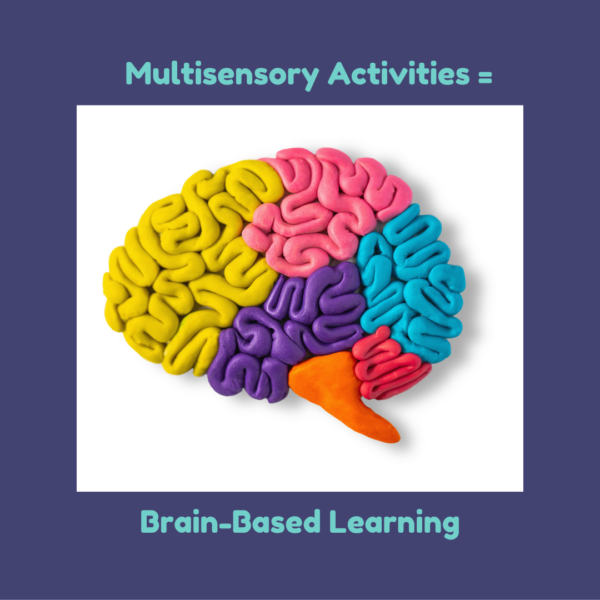
1. Understanding Brain-based Learning for Multisensory Activities
Brain-based learning is an educational approach that takes into account how our brains function and learn best. It recognizes that each individual’s brain is unique, and yet various parts of the brain have specific functions that fall into VATK input. By employing multisensory activities, homeschool parents can tap into various neural pathways, enhancing a secure emotional state, memory retention, and concept understanding. Repetitious practice also becomes a fun experience rather than a dull, ineffective drill exercise.
2. Sight: Visually Engaging Instruction
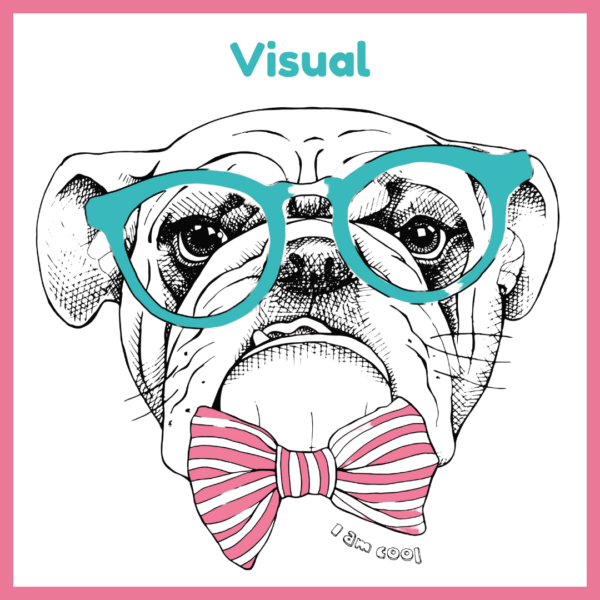
A visual example, or stimulus, plays a fundamental role in the learning process. Although many homeschoolers avoid all of the quizzes and tests that are present in public schools, moms frequently are “testing” to see what their child knows. Before removing a visual cue, be sure you have provided words, examples, math facts, or anchor charts for much longer than you think is necessary for learning to happen. Integrating colorful and interactive materials, such as flashcards, videos, diagrams, and multiplication charts, helps learners visualize concepts, making them more memorable and easier to comprehend. Illustrated storytelling, word clouds, and mind maps are also effective tools to engage the sense of sight in English learning.
Ideas for Visuals to Use Regularly in Multisensory Activities
Here are some practical ideas for using visuals for learning:
- Index Cards – I order 3×5 index cards in bulk on Amazon. I go through about 10 packs a year! Whenever we are working on spelling words, I write a word in large letters, preferable blue, purple, or dark red for intense contrast between the word and the white card. We use those cards by having them in front of the child for sand or rice tray spelling, magnet spelling, run-around spelling, and other fun activities. Your student sees the word many more times with information stored in the occipital lobe, the temporal lobe, the parietal lobe, and the frontal lobe of the brain! By the way, writing a word from memory 3 to 5 times only serves to make a word temporarily embedded, but involves only working memory and tactile skills, which many kids with dyslexia struggle with. This old technique of learning spelling words is usually ineffective and results in frustration and wasted time.
- Sensory bags or bins – You can embed Scrabble Tiles, plastic numbers, and other small objects into a bag of clear or lightly colored Jello. Duct tape the bag shut to securely keep the bag from leaking. Have your child find even or odd numbers, math facts to see and write on a white board, or smush the gel around to form a spelling word. Of course, you can have an index card with the math fact or word for a visual cue.
- Half-sheets of copy paper – As with the index cards, half-sheets of copy paper can be used to have the student copy a math fact or spelling word in large writing with a regular Crayola or Rose Art watercolor marker. Then lay a plastic embroidery canvas over the prompt and have your child use an index finger to trace over the fact/word, saying the equation or letters aloud.
- Folder Games – We love games at Unique Learners. Folder games are easy to assemble, and provide you with multiple opportunities to play a “real” game with math facts or words. Our games are designed so that you can play with your students so that everyone has the opportunity to win and no one is punished in the game for not knowing a fact or skill. We want kids to have fun playing!
- Videos – Short videos or long documentaries are excellent for multisensory learning. Some kids practice reading when closed caption is on or when singing karaoke with the words showing!
3. Hearing: Incorporating Auditory Stimuli
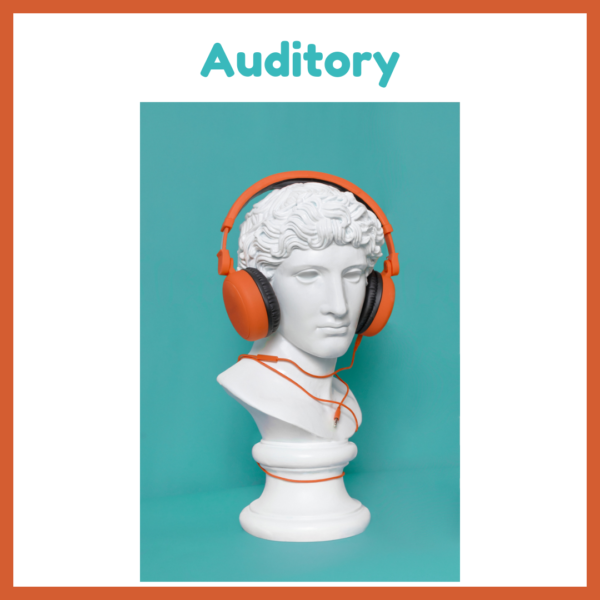
Listening is an essential for language acquisition and comprehension. However, many kids wtih language-based disabilities, like dyslexia and autism, do not always process language fast enough to catch information presented in multiple steps or with easily confused grammatical structure. Stimulating the auditory senses through activities like read-aloud sessions, auditory books, discussions, and listening to podcasts or classical music can strengthen listening skills.
The Charlotte Mason technique of narration can help you know what information a student has gleaned from activities and provides opportunity for clarification through discussion. Remember that we want to use several input strategies simultaneously.
For primary grades, I like to use any coloring page. Give one to five oral directions for how to color the picture. Have your child color something on the page in a certain color. Then have them make polka dots on a shirt. Draw a green balloon in the sky. Write the number 463 in the lower left corner. You have a visual on the paper and several components for listening and a tactile output!
Any of the visual activities listed above should be accompanied by you speaking the information and/or having your child say the letters, sounds, words, sentences, numbers, or math facts out loud. Vary how you have them say things. Here are some suggestions of various voices you can have your student try to make auditory practice funny (be sure to laugh a lot when you do these)!
- Say it like a football player
- Say it in a baby voice
- Say it really loud (shout it)
- Say it in a whisper
- Say it like a cat
- Say it like a boss
- Say it like a granny
4. Touch: Tactile Experiences for Language Learning
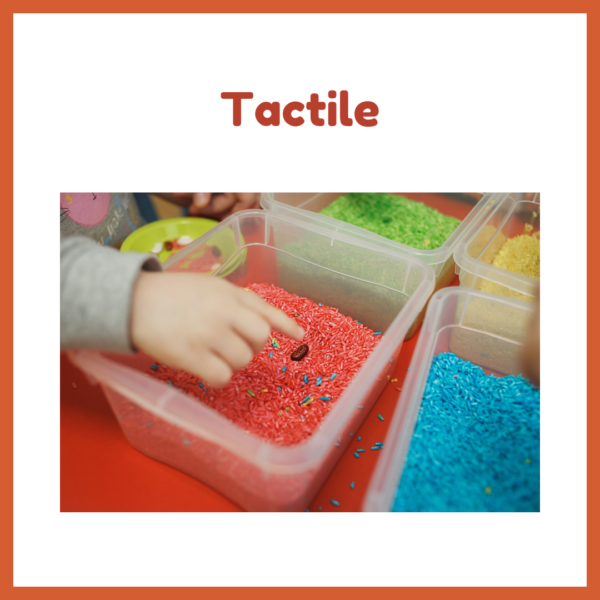
The sense of touch can be used to reinforce concepts and details. Incorporating hands-on activities, such as sensory bins with word cards, letter tracing, or using glue letter manipulatives for spelling, provides learners with physical connections to the language. For math, base 10 blocks, counting chips, a bucket balance, and fraction manipulatives integrate concepts and number relationships for more effective learning. Art activities for upper elementary students can strengthen writing, cutting, and eye-hand coordination. Teaching middle school and high schoolers to take notes and organize their paper can help integrate tactile, visual, and organizational (executive function) skills.
Here are some other tactile activities for students who are sensory seeking:
- Write spelling words on your arm with your other index finger. Of course provide a prompt on an index card and say the letters and word aloud.
- Play the back spelling guessing game. Have your child wear a swimsuit or lie down on their tummy. Make a letter or number with your index finger on the child’s back. Have the child guess the letter or number. Switch between capitals and lowercase letters as your child is able.
- Use various outdoor objects, like rocks, leaves, sticks, water, grass, dirt or sand, acorns, etc to have kids do math and spelling or work on sight words.
5. Movement: Energizing with Kinesthetic Learning
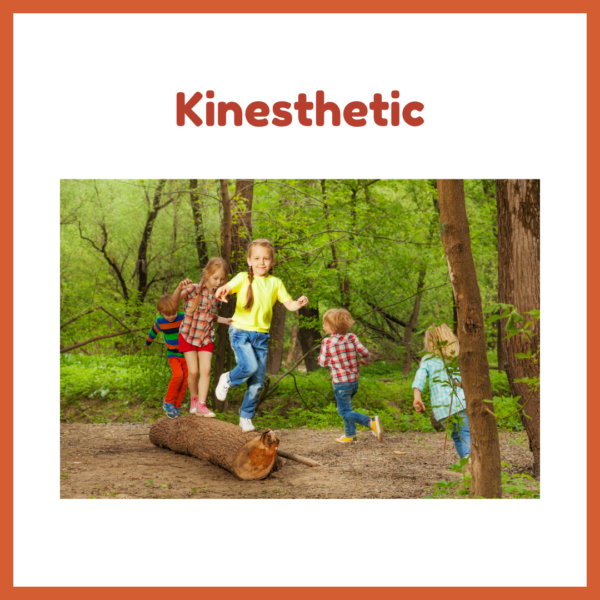
Create opportunities for movement and kinesthetic learning. Movement enhances memory, attention, and information processing. Incorporate actions, gestures, or physical activities like drama, role-plays, or language games provides active involvement and alternative communication strategies. The mind-body connection facilitated through movement supports a more comprehensive learning experience.
Anything done outdoors facilitates moving activities. My kids love to have a reading picnic. We take a stack of books, several blankets, and a bunch of snacks. We go to a park or even into the backyard under a tree. When we are settled, we read silently, sharing cool passages with each other. The kids will spend an hour reading, getting up to walk around, rolling over, shifting, swinging, and more!
Here are some more multisensory activities based mainly on movement:
- Snow painting skip counting or spelling
- Hopping from number to number for skip counting
- Reading while on a recumbent bike
- Scarf dancing and singing about vowels or grammar rules
- Run-Around spelling or math. Write letters of spelling words on index cards. Dictate a word and have your student run around in the backyard or family room to gather the word and spell it out in front of you.
- Hopscotch math – skip counting practice or play regular hopscotch by answering questions until your mover is out-of-bounds.
- Relay races for writing the times facts on a whiteboard
- Moving to Jack Hartman’s video for rhyming words
6. Smell and Taste: Incorporating Olfactory and Gustatory Experiences into Multisensory Activities
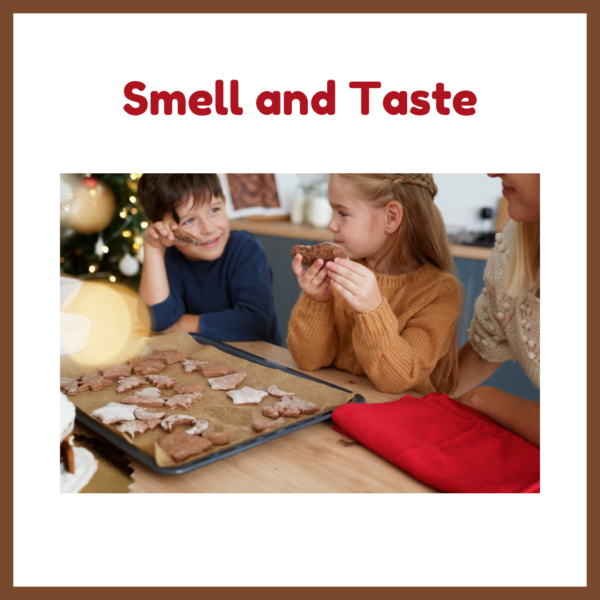
While not directly associated with VATK, we do have around 13 senses that can be incorporated into multisensory learning activities. Smell and taste certainly can be used for young children learning science concepts; however, you can make letter cookies, ice letters, Jello letters, scented playdough numbers and math facts, cinnamon and applesauce ornaments for writing brief notes, and tasting foods that are associated with concepts.
The more you can create associative hooks to different senses, the more your child with have detailed, sequential information stored in multiple areas of the brain. Using scented markers, associating specific smells with English vocabulary, or organizing cultural tasting events related to different countries add a multisensory component to the overall learning process, making it more immersive and memorable.
I had a student who loved to cook and was fascinated with flags. As we studied the landforms and culture of countries around the world, she would find a common food from each country and make it for her family. She would draw the flag of each country in a sketchbook. We would try out common words from each language, like hello, good-bye, please, thank you, yes, and no.
Conclusion:
Multisensory activities play a crucial role in ensuring brain-based learning by engaging multiple sensory channels simultaneously, such as visual, auditory, tactile, and kinesthetic. Incorporating multisensory activities into ensures brain-based learning, capitalizing on the brain’s ability to process and retain information by storing information in several areas of the brain through one lesson. The brain is stimulated in a more holistic manner, leading to enhanced memory retention, deeper comprehension, and improved cognitive development.
Rather than trying to guess about a child’s learning style or catering to a kid’s preferences, multisensory learning activities ensure that all of the kids are learning effectively and having fun at together, even if they are at different levels! These immersive experiences also foster a positive attitude towards learning. Overall, the incorporation of multisensory activities in education aligns with how the brain naturally learns and can optimize the learning process for individuals of all ages.
